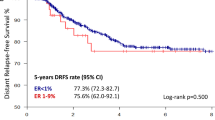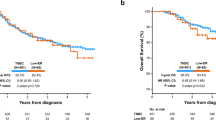Abstract
Studies on well characterized, large populations of estrogen receptor (ER)/progesterone receptor (PgR)/HER2-negative [triple-negative (TN)] breast cancer (BC) patients with long-term follow-up are lacking. In this study, we analyze clinical outcomes of TN BC and implications of epidermal growth factor receptor (EGFR) expression. Clinical and biologic features, time to first recurrence (TTFR), and overall survival (OS) were compared in 253 TN versus 1,036 ER positive, PgR positive, HER2-negative [estrogen-driven (ED)] BC. Compared to ED, TN tumors were larger (p = 0.02), more proliferative (high S-phase 54 vs. 17 %, p < 0.0001), more aneuploid (64 vs. 43 %, p < 0.0001) and more likely EGFR positive (≥10 fmol/mg by radioligand-binding assay, 49 vs. 7 %, p < 0.0001). Among TN, EGFR-positive BC were larger (p = 0.0018), more proliferative (p < 0.0001), and more aneuploid, (p < 0.0001) than EGFR-negative BC. Adjuvant-treated TN patients had shorter TTFR (p = 0.0003), and OS (p = 0.0017), than ED patients. However, in untreated patients, no differences in TTFR and OS were observed at 8 years median follow-up. Among TN patients, EGFR expression was not associated with worse outcome. TN tumors have a worse outcome in systemically treated patients but not in untreated patients. EGFR expression, does not predict for worse long-term survival.






Similar content being viewed by others
References
Perou CM, Sorlie T, Eisen MB et al (2000) Molecular portraits of human breast tumours. Nature 406:747–752
Sotiriou C, Neo SY, McShane LM et al (2003) Breast cancer classification and prognosis based on gene expression profiles from a population-based study. Proc Natl Acad Sci USA 100:10393–10398
Sorlie T, Perou CM, Tibshirani R et al (2001) Gene expression patterns of breast carcinomas distinguish tumor subclasses with clinical implications. Proc Natl Acad Sci USA 98:10869–10874
Sorlie T, Tibshirani R, Parker J et al (2003) Repeated observation of breast tumor subtypes in independent gene expression data sets. Proc Natl Acad Sci USA 100:8418–8423
Hartog H, Horlings HM, van der Vegt B et al (2011) Divergent effects of insulin-like growth factor-1 receptor expression on prognosis of estrogen receptor positive versus triple negative invasive ductal breast carcinoma. Breast Cancer Res Treat 129:725–736
Kreike B, van de Vijver MJ (2007) Are triple-negative tumours and basal-like breast cancer synonymous? Authors’ response. Breast Cancer Res 9(6):405
Bertucci F, Finetti P, Cervera N et al (2008) How basal are triple-negative breast cancers? Int J Cancer 123:236–240
Cheang MCU, Voduc D, Bajdik C et al (2008) Basal-like breast cancer defined by five biomarkers has superior prognostic value then triple-negative phenotype. Clin Cancer Res 14:1368–1376
Dent R, Trudeau M, Sun P, Narod S (2007) Patterns of metastatic spread in triple negative breast cancer. Breast Cancer Res Treat 106:S41–S83
McGuire WL et al (1977) Evaluation of estrogen receptor assays in human breast cancer tissue. Cancer Res 37:637–639
Powell B et al (1979) Measurement of progesterone receptor in human breast cancer biopsies. Cancer Res 39:1678–1682
Clark GM, Dressler LG, Owens MA, Mcguire WL (1988) Flow-cytometry identifies a group of node-negative breast-cancer patients with low-risk of recurrence. Breast Cancer Res Treat 12:132
Dressler LG, Seamer LC, Owens MA et al (1988) DNA flow-cytometry and prognostic factors in 1331 frozen breast-cancer specimens. Cancer 61:420–427
Clark GM, Mathieu MC, Owens MA et al (1992) Prognostic-significance of s-phase fraction in good-risk, node-negative breast-cancer patients. J Clin Oncol 10:428–432
Clark GM, Dressler LG, Owens MA et al (1989) Prediction of relapse or survival in patients with node-negative breast-cancer by DNA flow-cytometry. N Engl J Med 320:627–633
Wenger CR, Beardslee S, Owens MA et al (1993) DNA-ploidy, S-phase, and steroid-receptors in more than 127, 000 breast-cancer patients. Breast Cancer Res Treat 28:9–20
Ciocca DR, Fujimura FK, Tandon AK et al (1992) Correlation of Her-2/Neu amplification with expression and with other prognostic factors in 1103 breast cancers. J Natl Cancer Inst 84:1279–1282
Klijn JGM, Berns PMJJ, Bontenbal M, Foekens JA (2006) Growth-factors: clinical implications in breast-cancer. Breast Cancer: from Biology to Therapy. doi:10.1111/j.1749-6632.1993.tb17193.x
Curigliano G, Goldhirsch A (2011) The triple-negative subtype: new ideas for the poorest prognosis breast cancer. J Natl Cancer Inst Monogr 43:108–110
Arpino G, Weiss H, Lee AV et al (2005) Estrogen receptor-positive, progesterone receptor-negative breast cancer: association with growth factor receptor expression and tamoxifen resistance. J Natl Cancer Inst 97:1254–1261
Kaufmann M, Pusztai L (2011) Use of standard markers and incorporation of molecular markers into breast cancer therapy consensus recommendations from an international expert panel. Cancer 117:1575–1582
Huo DZ, Senie RT, Daly M et al (2009) Prediction of BRCA mutations using the BRCAPRO model in clinic-based African American, Hispanic, and other minority families in the United States (vol 27, p 1184, 2009). J Clin Oncol 27:3262
Stead LA, Lash TL, Sobieraj JE et al (2009) Triple-negative breast cancers are increased in black women regardless of age or body mass index. Breast Cancer Res 11:R18. doi:10.1186/bcr2242
Dowsett M, Houghton J, Iden C et al (2006) Benefit from adjuvant tamoxifen therapy in primary breast cancer patients according oestrogen receptor, progesterone receptor, EGF receptor and HER2 status. Ann Oncol 17:818–826
Leitzel K, Souder C, Ali SM et al (2005) Serum EGFR/HER-2 combination predicts poor survival in metastatic breast cancer. (J Clin Oncol Meeting Abstracts) 23(16): 9613
Lu CH, Speers C, Zhang Y et al (2003) Effect of epidermal growth factor receptor inhibitor on development of estrogen receptor-negative mammary tumors. J Natl Cancer Inst 95:1825–1833
Nicholson RI, Gee JM, Harper ME (2001) EGFR and cancer prognosis. Eur J Cancer 37(Suppl 4):S9–S15
Press MF, Finn RS, Cameron D et al (2008) HER-2 gene amplification, HER-2 and epidermal growth factor receptor mRNA and protein expression, and lapatinib efficacy in women with metastatic breast cancer. Clin Cancer Res 14:7861–7870
Rimawi MF, Weiss HL, Bhatia P et al (2006) EGFR expression in breast cancer: association with biologic phenotype, prognosis, and resistance to adjuvant therapy. J Clin Oncol (Meeting Abstracts) 24(18): 513
Rimawi MF, Shetty PB, Weiss HL et al (2010) Epidermal growth factor receptor expression in breast cancer association with biologic phenotype and clinical outcomes. Cancer 116:1234–1242
Carey L, Mayer E, Marcom P et al (2007) TBCRC 001: EGFR inhibition with cetuximab in metastatic triple negative (basal-like) breast cancer (abstract 307). Breast Cancer Res Treat 106(suppl 1):S32
Viale G, Rotmensz N, Maisonneuve P et al (2009) Invasive ductal carcinoma of the breast with the “triple-negative” phenotype: prognostic implications of EGFR immunoreactivity. Breast Cancer Res Treat 116:317–328
Kolodner RD, Cleveland DW, Putnam CD (2011) Aneuploidy drives a mutator phenotype in cancer. Science 333:942–943
Irshad S, Ellis P, Tutt A (2011) Molecular heterogeneity of triple-negative breast cancer and its clinical implications. Curr Opin Oncol 23:566–577
Banerjee S, Reis JS, Ashley S et al (2006) Basal-like breast carcinomas: clinical outcome and response to chemotherapy. J Clin Pathol 59:729–735
Dent R, Trudeau M, Pritchard KI et al (2007) Triple-negative breast cancer: clinical features and patterns of recurrence. Clin Cancer Res 13:4429–4434
Dent R, Trudeau M, Pritchard K et al (2007) Patterns of recurrence and prognosis in women with basal-like breast cancer. Breast 16:S25
Kreike B, van de Vijver MJ (2007) Are triple-negative tumours and basal-like breast cancer synonymous? Breast Cancer Res 9(6): 405. doi:10.1186/bcr1832
Kreike B, van Kouwenhove M, Horlings H et al (2007) Gene expression profiling and histopathological characterization of triple-negative/basal-like breast carcinomas. Breast Cancer Res 9(5):R65
Hilsenbeck SG, Ravdin PM, de Moor CA et al (1998) Time-dependence of hazard ratios for prognostic factors in primary breast cancer. Breast Cancer Res Treat 52:227–237
Dawood S, Broglio K, Buzdar AU et al (2010) Prognosis of women with metastatic breast cancer by HER2 status and trastuzumab treatment: an institutional-based review. J Clin Oncol 28:92–98
Acknowledgments
The Authors have no financial disclosures to declare. This study was funded in part by a NIH grant P50-CA58183 (SPORE) and a Susan Komen for the Cure Foundation Post-doctoral Fellowship Award.
Author information
Authors and Affiliations
Corresponding author
Rights and permissions
About this article
Cite this article
Malorni, L., Shetty, P.B., De Angelis, C. et al. Clinical and biologic features of triple-negative breast cancers in a large cohort of patients with long-term follow-up. Breast Cancer Res Treat 136, 795–804 (2012). https://doi.org/10.1007/s10549-012-2315-y
Received:
Accepted:
Published:
Issue Date:
DOI: https://doi.org/10.1007/s10549-012-2315-y




